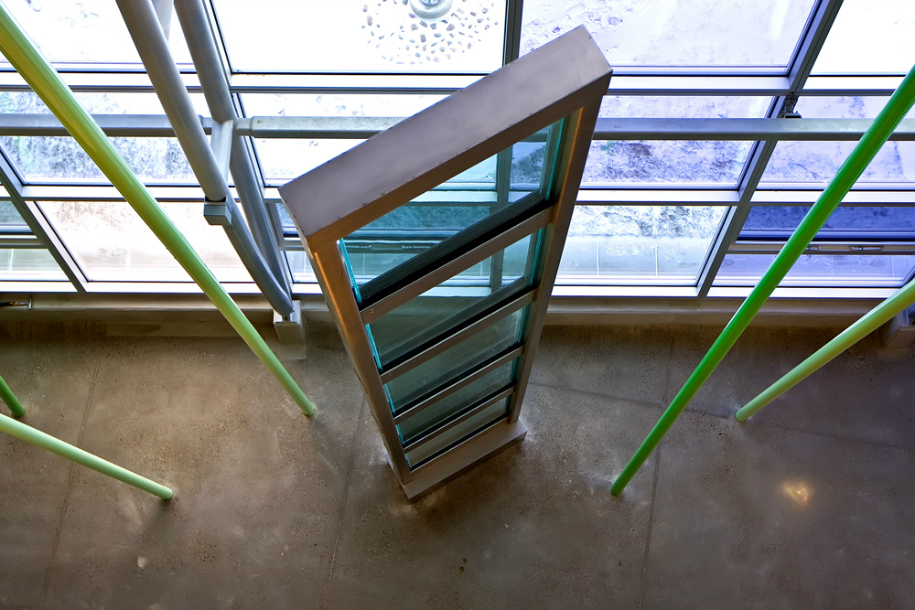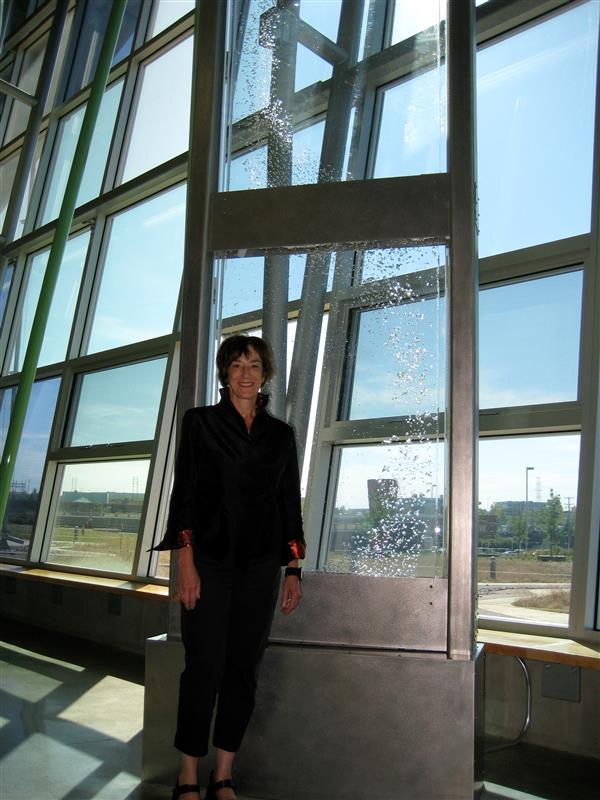Water Garden - Public Artwork
Project details
Title of Artwork: Water Garden
Artist: Linda Covit
Location: The Water Centre — 25th Ave. S.E. and Spiller Road.
Commissioned by: Utilities and Environmental Protection
Project Completion: 2009
Water Garden by Linda Covit was located in The City of Calgary Water Centre for over a decade. The artwork had experienced complex technical issues in recent years, related to the loss of specialized parts and services. After consulting with the artist and thoroughly exploring restoration options, the decision was made to deaccession the piece.
Water Garden was removed from the Water Centre in December 2024 and was responsibly recycled.

Concept
Water Garden was a sculptural installation located in the lobby of The City of Calgary Water Centre. This project used water to reflect and celebrate the many services of The City's Water Services department.
Water Garden visually translated the Water Centre's purpose. Upon approaching the building lobby, the viewer was offered a glimpse of the clear glass panels and floating bubbles within. The rhythmic placement of the poles installed at differing angles evoked a wooded grove and referenced nature. The installation embraced the abundance of natural light, offering interplay of light and shadow.
The generous spacing of the elements, the use of clear glass and water and the continuous movement of bubbles contributed to the fluidity and transparency prevalent in the architecture. The juxtaposition of these elements signified the importance of water to all forms of life, and so celebrates The City of Calgary Water Centre.
The artist
Linda Covit was born in Montreal, Canada, where she lives and works. A professional, self-taught visual artist, her site-responsive installations are often concerned with nature and the environment. She has completed public commissions within Canada, the U.S and Japan including a hospital garden installation, peace monument, memorial sculpture fountain and theatre sculpture.
Linda has received grants from the Canada Council, the Japan-Canada fund, the Cirque du Soleil, and the Pollock-Krasner Foundation in New York.

Q&A with Linda Covit (December 2024)
Although the work has been removed, we will continue to remember and celebrate the artwork. Our Collection Specialist Candace spoke to Linda in December to learn more about her creative practice and inspirations for Water Garden. Below is an excerpt of their conversation.
What drew you to being an artist?
I finished my undergraduate studies in science, majoring in psychology at McGill University (Montréal). Although I thought of continuing postgraduate work, I decided to take some time off and did research for a psychology professor for several years. I enjoyed that, but decided I didn’t want to stay in the academic world. I found it somewhat enclosed, not realizing at the time that the art world is as well.
While doing the research I started taking fibre art classes at the Visual Arts Centre in Montréal. I began making very large fibre hangings and discovered Powerhouse Gallery, a women’s artist-run centre in Montréal where I had my first show. Being a self-taught artist, I developed different techniques as I worked. At some point I wanted something more solid than fibre and started to learn how to weld and work with metal. Eventually I got a camera and traveled a lot, photographing gardens in Europe. After this I went to Japan to photograph gardens there. That trip had a huge impact on me and changed my approach in my art.
It sounds like you started with the traditional route of exhibiting in galleries, how did you make the jump into public art?
After the first trip to Japan I made my first installation for an exhibition. A tiered row of sculptural elements at the end of a very large black reflecting pool, it was conceived for the dimensions of the gallery space. This led to developing large installations for specific spaces, which were difficult to store. I then decided to submit my work to Quebec’s Integration of Art into Architecture (1%) program. I found the more I was doing public art, the more I was interested in it and in creating site-responsive works. Among other things, I could work with natural light and shadow in a way that I couldn’t in galleries. Public art gave me a chance to use different materials, I didn’t have a storage problem and of course it had budgets that let me do larger works. I enjoy working at a large scale and will fill whatever size space I’m given. And, there is the interaction with people in a daily setting outside of a museum or gallery.
Is that something that’s carried through your creative practice working with light and shadows in public spaces?
Yes, it has. Water has also been present in many of my projects, although this can be more as a theme or metaphor than an actual material. It’s what drew me to the Water Centre competition, as well as the chance to travel, going to a place I had never been before. This public artwork was my first opportunity to work with water which I appreciated.
The project was done quite some time ago with the call released in 2005. Do you remember your experience coming to Calgary and what you thought of Calgary?
Of course, I totally remember. When I arrived and walked through the airport, I thought I’d never get this competition because the artwork in the airport was very traditional at the time. There was a lot of cowboy imagery and sculptures, so different from what I was proposing. It was also Calgary Stampede when I arrived, which was wonderful. I got to see a vision of Calgary that is very specific to that part of the year. The presentation went well despite some technical difficulties, and I enjoyed the people. I was surprised when I won. I was thrilled, actually.
How did you develop the concept for Water Garden?
As I usually do when I start a new project, I made small paper or cardboard maquettes of the lobby to help me understand the space and develop something for it. Calgary was a challenge because the area for the artwork was very narrow and very tall. There’s a lot of glazing so a lot of light coming through. The many different points of view were interesting - you can see the artwork from outside, as you walk in, and from the four stories looking down on it. All of that fed into what I was working on and the idea I had from the beginning – a swirl of bubbles. The architecture of the building had transparency, there was the concept of fluidity, and it was a water centre. I wanted to continue that in the work as a way to celebrate the Water Centre, but to also fit the work into that space and have a presence. With the soaring ceilings it had to be very tall.
The tubes were like a grove of trees, a reference to nature. They also recalled the Water Centre’s connection with the environment. I thought the bubbles would call to people to come and have a closer look and stay to watch their movement. From the beginning I had wanted it to be very slow and quiet. Even though the column’s water aquariums were separate because of their size, it was programmed to look like a continuous swirl moving through the different sections.
One of my favourite experiences at the Water Centre was when I was waiting for a photographer to arrive. A woman came in with a group of people showing them the Water Centre. She obviously worked there and then she walked up to the water column and hugged it saying, “I just love this piece, this is my favourite part of the building”. That was really special. I didn’t say anything, I could have introduced myself, but I didn’t. It really struck me, and it was great to know there’s at least one person that really loves this work.
Learn more about Linda Covit and see her other artworks here.

